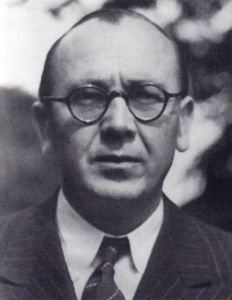Kurt Diebner (1905-1964) was a German nuclear physicist and the administrative director of the secret Nazi German nuclear weapons program.
EARLY YEARS
Diebner was born on May 13, 1905 in Obernessa, Weißenfels in the German Empire. He studied physics at Martin Luther University of Halle-Wittenberg and graduated with a B.S. in 1928. Continuing his academic studies, in 1930 Diebner received an M.S. in physics from Leopold Frazens University of Innsbruck. He returned to Halle University and earned his Ph.D. in 1932.
Diebner worked as a teaching assistant to nuclear physicist Gerhard Hoffman from 1931-1934. He then became a researcher at the Reich Physical and Technical Institute (PTR) and served as an advisor on nuclear physics to the Reich Ministry of Defense and the Army Ordinance Office (HWA).
WORLD WAR II AND THE GERMAN ATOMIC BOMB PROGRAM
During World War II, Diebner served as the Director of the German Army’s Nuclear Research Council. He was among the leading nuclear physicists of the Uranverein, or “Uranium Group”, tasked with researching and developing a Nazi nuclear bomb. On September 16, 1939, days after the outbreak of the Second World War, Diebner organized the group’s first meeting. At the meeting, it was determined that the Kaiser-Wilhelm Institute for Physics was subject to the authority of the Army Ordinance Office, and that Diebner was to oversee the Nazi military’s nuclear weapons research project as its administrative director.
The German bomb program was divided between the theoretical physicists led by Werner Heisenberg and the more experimental scientists led by Diebner. Initially, the groups worked independently of one another and the relationship between the two was characterized by intense competition.
Since the earliest indications that nuclear fission could lead to the creation of weapons, Diebner was optimistic about the prospects of a German atomic bomb. His group of researchers designed schematics for a more efficient uranium reactor than Heisenberg’s group. Along with other factors such as wartime pressure and scarce resources, this eventually led the two teams to cooperate on atomic research and development.
However, once German scientists determined that a bomb would not be complete before the end of the war, Germany’s atomic program was abandoned. Diebner served as a Reich Planning Officer for the Army until the end of the war.
LATER YEARS
Diebner was among the German scientists captured and interned by the Allies’ Alsos Mission at Farm Hall in England in May 1945. Reflecting on reasons why the German scientists failed to build a bomb, Diebner explained, “the official people were only interested in immediate results. They didn’t want to work on a long-term policy as America did.”
Eventually, Diebner and the other scientists were repatriated to Germany in 1946. Diebner later established the Society for Nuclear Ship Propulsion. As a member of Gesellschaft zur Kernenergieverwertung in Schiffbau und Schiffahrt m.b.H, the “Company for the Commercial Exploitation of Nuclear Energy in Ship Building”, his research focused on developing ways to fuel ships with nuclear energy. Beginning in 1957, he lectured intermittently at the School of Naval Engineers in Flensburg. He died at the age of 59 on June 13, 1964 in Oberhausen, West Germany.





